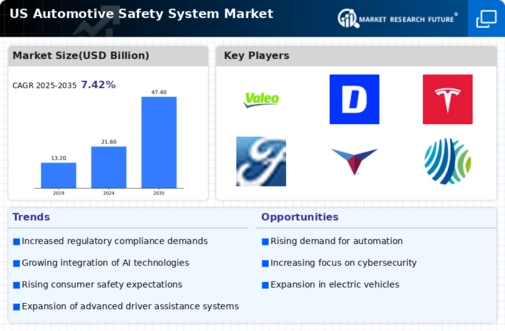The US Automotive Safety System Market is characterized by rapid advancements and a growing emphasis on safety technologies, driven by increased regulatory requirements and consumer demand for enhanced vehicle safety. The competitive landscape is shaped by various key players that offer an array of innovative safety solutions, such as advanced driver assistance systems (ADAS), electronic stability control, and active safety features. Companies are leveraging cutting-edge technologies, including artificial intelligence, machine learning, and sensor technologies, to enhance the effectiveness of their products.
As the market continues to expand, competitive insights reveal a dynamic environment in which organizations must continually adapt and innovate to not only meet consumer expectations but also to comply with evolving safety regulations mandated by authorities.Valeo has established a strong presence in the US Automotive Safety System Market, focusing on providing advanced safety technologies aimed at improving vehicle safety and reducing the risk of accidents.
The company is highly regarded for its commitment to research and development, leading to the creation of innovative products like vision systems, range sensors, and advanced driver assistance systems, which are integral in modern automotive safety. Valeo's strengths lie in its extensive portfolio and ability to integrate different safety solutions, enabling a comprehensive offering that appeals to US automakers.
By forming strategic partnerships and collaborations with OEMs, Valeo enhances its market reach and solidifies its competitive positioning within the region, demonstrating a clear commitment to advancing automotive safety in the United States.ZF Friedrichshafen has made significant strides in the US Automotive Safety System Market, capitalizing on its robust portfolio that includes a range of advanced safety technologies and systems. The company is well-known for its innovative solutions in passive safety systems, active safety technologies, and vehicle dynamics management, positioning it as a key player in the market.
ZF's market presence in the US is strengthened through its continuous investments in research and development, allowing the company to pioneer new safety features that adapt to changing regulatory landscapes. Additionally, ZF has engaged in strategic mergers and acquisitions to enhance its technological capabilities and broaden its product offerings in the automotive safety sector. This proactive approach has not only fortified ZF’s competitive edge but has also reinforced its commitment to delivering cutting-edge safety solutions tailored for the US automotive industry.
























Leave a Comment